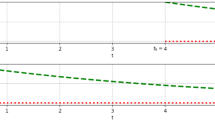Summary
We show that for every discount factorρε(0,1) one can find infinitely many strictly concave discrete-time optimal growth models in reduced form which have optimal policy functions exhibiting ergodic chaos. These reduced form models are interpreted in a two-sector optimal growth setting with utility functions depending on consumption as well as on capital.
Similar content being viewed by others
References
Boldrin, M., Montrucchio, L.: On the indeterminacy of capital accumulation paths. J. Econ. Theory40, 26–39 (1986)
Boldrin, M., Woodford, M.: Equilibrium models displaying endogenous fluctuations and chaos: a survey. J. Monetary Econ.25, 189–222 (1990)
Brock, W. A., Scheinkman, J. A.: Global asymptotic stability of optimal control systems with applications to the theory of economic growth. J. Econ. Theory12, 164–190 (1976)
Cass, D., Shell, K.: The structure and stability of competitive dynamical systems. J. Econ. Theory12, 31–70 (1976)
Day, R. H., Pianigiani, G.: Statistical dynamics and economics. J. Econ. Behav. Organiz.16, 37–83 (1991)
Deneckere, R., Pelikan, S.: Competitive chaos. J. Econ. Theory40, 13–25 (1986)
Devaney, R. L.: An introduction to chaotic dynamical systems. Menlo Park: Benjamin Cummings 1986
Eckmann, J. P., Ruelle, D.: Ergodic theory of chaos and strange attractors. Rev. Modern Physics57, 617–656 (1985)
Frank, M., Stengos, T.: Chaotic dynamics in economic time-series. J. Econ. Surveys2, 103–133 (1988)
Lasota, A., Yorke, J. A.: On the existence of invariant measures for piecewise monotonic transformations. Trans. Amer. Math. Soc.186, 481–488 (1973)
Li, T. Y., Yorke, J. A.: Period three implies chaos. Am. Math. Monthly82, 985–992 (1975)
Li, T. Y., Yorke, J. A.: Ergodic transformations from an interval into itself. Trans. Amer. Math. Soc.235, 183–192 (1978)
Majumdar, M., Mitra, T.: Periodic and chaotic programs of optimal intertemporal allocation in an aggregative model with wealth effects. Econ. Theory4, 649–676 (1994)
Majumdar, M., Mitra, T.: Robust ergodic chaos in discounted dynamic optimization models. Econ. Theory4, 677–688 (1994)
McKenzie, L. W.: Turnpike theory. Econometrica44, 841–865 (1976)
McKenzie, L. W.: Turnpike theory, discounted utility, and the von Neumann facet. J. Econ. Theory30, 330–352 (1983)
Montrucchio, L.: Dynamical systems that solve continuous-time concave optimization problems: anything goes. In: Benhabib, J. (ed.) Cycles and chaos in economic equilibrium, pp. 277–288. Princeton: Princeton University Press 1989
Montrucchio, L.: Optimal paths of any kind and discount factors for strongly concave problems. J. Optimization Theory Appl. (forthcoming)
Nishimura, K., Yano, M.: Optimal chaos, nonlinearity and feasibility conditions. Econ. Theory4, 689–704 (1994)
Nishimura, K., Yano, M.: Non-linear dynamics and chaos in optimal growth. Mimeo, Kyoto University 1992
Rasband, S. N.: Chaotic dynamics of nonlinear systems. New York, Chichester: John Wiley & Sons 1990
Sarkovskii, A. N.: Coexistence of cycles of a continuous map of the real line into itself. Ukrainian Math. J.16, 61–71 (1964)
Scheinkman, J. A.: On optimal steady states ofn-sector growth models when utility is discounted. J. Econ. Theory12, 11–30 (1976)
Sorger, G.: On the minimum rate of impatience for complicated optimal growth paths. J. Econ. Theory56, 160–179 (1992)
Sorger, G.: Minimum impatience theorems for recursive economic models. Heidelberg, New York: Springer 1992
Sorger, G.: On the sensitivity of optimal growth paths. Working paper, University of Vienna 1992
Sorger, G.: Period three implies heavy discounting. Math. Oper. Res. (forthcoming)
Stokey, N. L., Lucas, R. E. Jr. (with Prescott, E. C): Recursive methods in economic dynamics. Cambridge: Harvard University Press 1989
Yano, M.: Teoria del equilibrio con sendas convertentes. Cuadernos Economicos46, 27–59 (1990)
Author information
Authors and Affiliations
Additional information
We thank Luigi Montrucchio for pointing out an error in a previous version of the paper.
Rights and permissions
About this article
Cite this article
Nishimura, K., Sorger, G. & Yano, M. Ergodic chaos in optimal growth models with low discount rates. Econ Theory 4, 705–717 (1994). https://doi.org/10.1007/BF01212026
Received:
Revised:
Issue Date:
DOI: https://doi.org/10.1007/BF01212026




